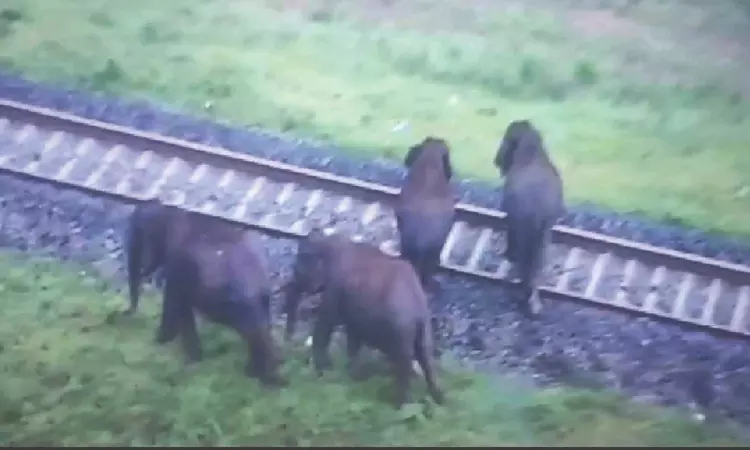Automated AI cameras begin real-time detection of jumbos crossing rly lines
Technology-based solutions were introduced after 11 jumbos including five she elephants, four tuskers, one makhna, and a calf were knocked down by trains since 2008 along the TN-Kerala border

AI-enabled cameras capture elephants on track during day
COIMBATORE: After months of trial runs through manual interventions, the Artificial Intelligence (AI) enabled elephant monitoring system has started to detect and send alerts on a real-time basis of wild elephants coming near the railway track connecting Tamil Nadu with Kerala in the Madukkarai forest range in Coimbatore.
“It has been over a week since the AI system got completely automated to identify and record jumbos near the tracks. After automation, the AI cameras have been generating up to three alerts on animal movements every day. Since its inception, it has been trained to identify elephants by feeding their snapshots in the system as and when they come near the tracks. Up to 5,000 images of any animal had to be fed into the system as part of the machine learning process to identify the animal,” said P Santhiya, Forest Range Officer, Madukkarai Range.
Thus far, a team of forest department staff used to monitor elephants round the clock from a control room and record their movement to issue alerts. Nevertheless, this task has now been taken over by AI technology to end elephants being run over by trains.
Still, the forest department believes that AI technology needs further improvisation to prove its efficiency in the long run.
Night hours in Madukkarai forest area
“Currently, AI-enabled cameras can identify an elephant only if it finds the image of either the entire animal or at least 50 percent of its body in focus. Therefore, the process of training AI to detect with accuracy, even if a small portion of its body like the tail or trunk of an elephant is seen in the focus area of the camera. It is an ongoing process,” the official said.
As many as 12 towers, with a height of 20 metres have been installed on strategic spots on a stretch of 7.05 kms, of which 2.9 km is in the ‘A’ line and 4.15 km is in the ‘B’ line. The cameras, with coverage of 150 metres on either side of the track, can detect the movement of elephants as well as wild animals like gaur, sambar deer, spotted deer, and leopards found in the Madukkarai forest area. The normal cameras will function during the day, while thermal cameras get activated at night to automatically send alerts to the control room on a real-time basis.
Besides officials and staff of the forest department, the loco pilots and officials of the Southern Railway will receive SMS alerts, if an elephant movement is detected. This will enable the forest department to take up driving operations and the loco-staff to slow down the train to prevent hitting an elephant.
The technology-based solutions were introduced after a total of 11 elephants including five females, four tuskers; one makhna (tuskless male), and an elephant calf were knocked down by trains since 2008. They got killed when the elephants attempted to cross over the tracks to enter villages in search of food and water.
Forest personnel heave sigh of relief as migration season ends earlier than usual
Railway underpass in Madukkarai area
Even as construction of the second underpass to facilitate elephants to cross the railway tracks safely in the Madukkarai forest area has taken off, the Coimbatore forest department is heaving a sigh of relief as elephants that migrated to Coimbatore have ended their sojourn earlier than usual.
The elephants arrived in large numbers much ahead of the actual migratory season, which normally starts in November and ends by March. Besides residential elephants, more than five elephant herds comprising ten to 15 members each came to Coimbatore from the neighbouring state earlier than usual in the months of September and October. Most of these herds have moved over to their next destinations through various migratory corridors in Coimbatore, unlike last year, when they stayed back longer than usual.
“Curiously, we see a significant change in their pattern of movement. These migrated elephant herds, with some accompanied by their calves, found comfort in using the recently completed underpass. Nevertheless, there are two elephants; one with a single tusk that have stayed back and are not accustomed to go by the underpass as they prefer to cross over by the tracks,” said P Santhiya, Forest Range Officer, Madukkarai Range.
The forest department hasn’t made any efforts to divert them into the underpass built at Rs 7.49 crore on the B line between Ettimadai and Walayar as it would make the elephant feel stressed.
“Once the railway executes its proposal to fence the tracks, then these elephants would go by the underpass. Also, the construction of the second underpass has begun and is likely to take around six months to get over. Because of the drop in the movement of migratory elephants, we have been heaving a sigh of relief over the last three weeks. It could be either because of good rains in their residential area, where they might have got better fodder and water,” the official added.



